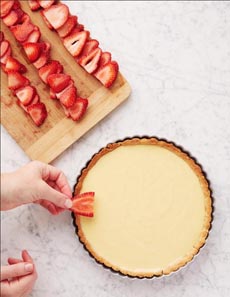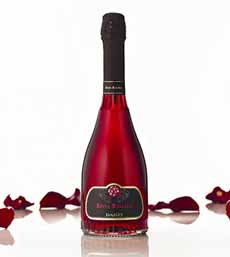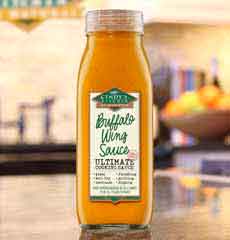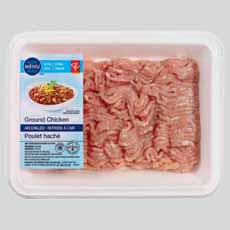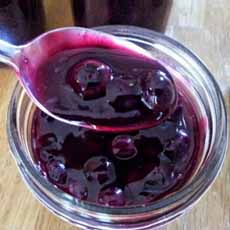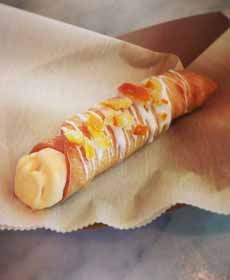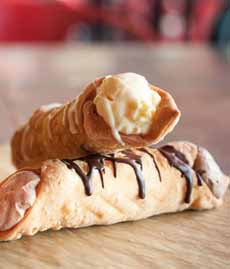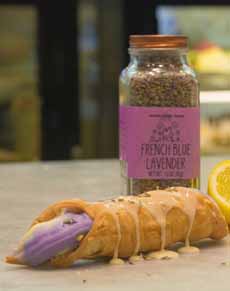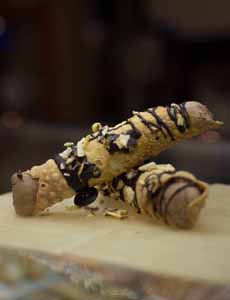
[1] Chocolate Amaretto Cannoli (all photos except #5 © Piccione Pastry | St. Louis).

[2] Carrot Cake Cannoli. You can port your favorite cake flavor into cannoli cream.

[3] Chocolate Cherry Cannoli, its shell dipped in a hard chocolate.

[4] Maple Bacon Cannoli, maple cannoli cream topped with a strip of caramelized bacon affixed with chocolate drizzle.
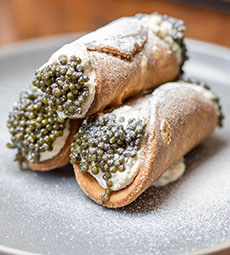
[5] There are also savory cannoli, typically created by high-end chefs. This smoked whitefish and cavoar cannoli is just one option. We’ve had them filled with truffled mashed potatoes and smoked salmon with goat cheese (photo © Pearl Street Caviar).
|
|
What’s a cannoli lover to do when she discovers a bakery that specializes in cannoli with fillings of every description?
She plans a fantasy vacation to St. Louis, to visit the source: Piccione Pastry. [Editor’s Note: Sadly, the bakery has closed, a victim of the pandemic.]
It’s the home of scores of flavors of Crazy Cannoli, the only problem is that the bakery features just one special flavor a week. Hmmm…move to St. Louis?
With a fantasy like this, our only recourse is to make the flavors at home. Not one a week, of course; but we’re trying for one a month. At this rate, we have years to go, just to make a portion of Piccione’s output.
Oh, and a hack: You can buy the cannoli shells from an Italian bakery.
Some of the flavors are > below, but first…
> National Cannoli Day is celebrated on June 16th, and September is National Cannoli Month.
> The year’s 15+ pastry holidays.
> The history and different types of pie and pastry: a photo glossary.
THE HISTORY OF CANNOLI
A Sicilian pastry originating in the area around Palermo, cannoli date to the ninth century. They were made for Carnevale, the festival season immediately before Lent. But the demand for the crunchy, sweet treats evolved to satisfy pastry lovers year-round.
Cannoli is actually the plural form of the word. The singular is cannolo (cannolu in Sicilian dialect), meaning “little tube.” Cannoli range in size from finger-sized cannulicchi (mini-cannoli) to five-inch-long shells.
The crunchy, fried pastry dough shell is filled with a sweetened ricotta cream (sometimes mascarpone), which can be mixed with vanilla, chocolate chips, chopped pistachio nuts, candied citron, marsala, rosewater, liqueur and other flavorings.
The filling at the ends of the shell can be decorated with mini chips, shaved chocolate or chopped pistachio nuts. The ends can be dipped in chocolate; or the whole cannolo can be dipped.
September is National Cannoli Month. June 16th is National Cannoli Day.
HOW TO MAKE CANNOLI
Cannoli shells are made from, flour, butter, sugar and optional seasonings (a pinch of cinnamon is particularly nice).
The dough is then rolled into ovals, wrapped around a cannoli tube and fried. The cooled shells are filled with a pastry bag.
The filling is ricotta, or the richer mascarpone, sweetened with sugar and enhanced with a bit of vanilla. Chocolate filling is a variation.
That’s the standard cannolo found in the U.S., but the filling can be much more nuanced, blended with any variety of ingredients such as marsala wine, rosewater, chocolate bits or chopped pistachio nuts.
Here’s a basic recipe and video from Food Network chef Alex Guarnaschelli.
Note to new cannoli makers: The shells shouldn’t be filled until you’re ready to serve. If left to sit too long, the moist filling turns the shell soggy and lose its crunch.
FLAVOR INSPIRATION
Start with classic vanilla cannoli, then let your imagination soar (there are even gender reveal cannoli, photo #7).
Like lemon meringue pie? Make lemon meringue cannoli. Red velvet cake? Make red velvet cannoli.
Here are just some of the creative flavors at Piccione Pastry, that start with the basic cannoli cream plus mix-ins or infusions:
Apple Cinnamon Cannoli, mixed with apple filling and topped with apple jack sauce and dried apple chips.
Banana Cream Pie Cannoli, infused with banana pudding, vanilla wafers and topped with meringue.
Bananas Foster Cannoli, blended with bananas caramelized with brown sugar, cinnamon, rum, and rum brown sugar glaze.
Blackberry Hard Cider Cannoli, mixed with fresh blackberries, the ends are dipped in a streusel crumbs.
Blueberry Cobbler Cannoli, mixed with a fresh blueberry sauce.
Blueberry Mint Mojito Cannoli, blueberry pastry cream with fresh blueberries and mint drizzle.
Breakfast Cannoli Cannoli, coffee cream, ends of cinnamon Chex cereal, then the whole thing is drizzled in maple syrup and powdered sugar.
Candy Crazy Cannoli, mixed with Twix, Kit Kat, Heath Bar, Whoppers and Nerds.
Carrot Cake Cannoli, photo #2, cannoli cream with pieces of carrot cake.
Cheddar Apple Pie Cannoli, cannoli cream mixed with cinnamon apples and topped with melted cheddar cheese.
|

